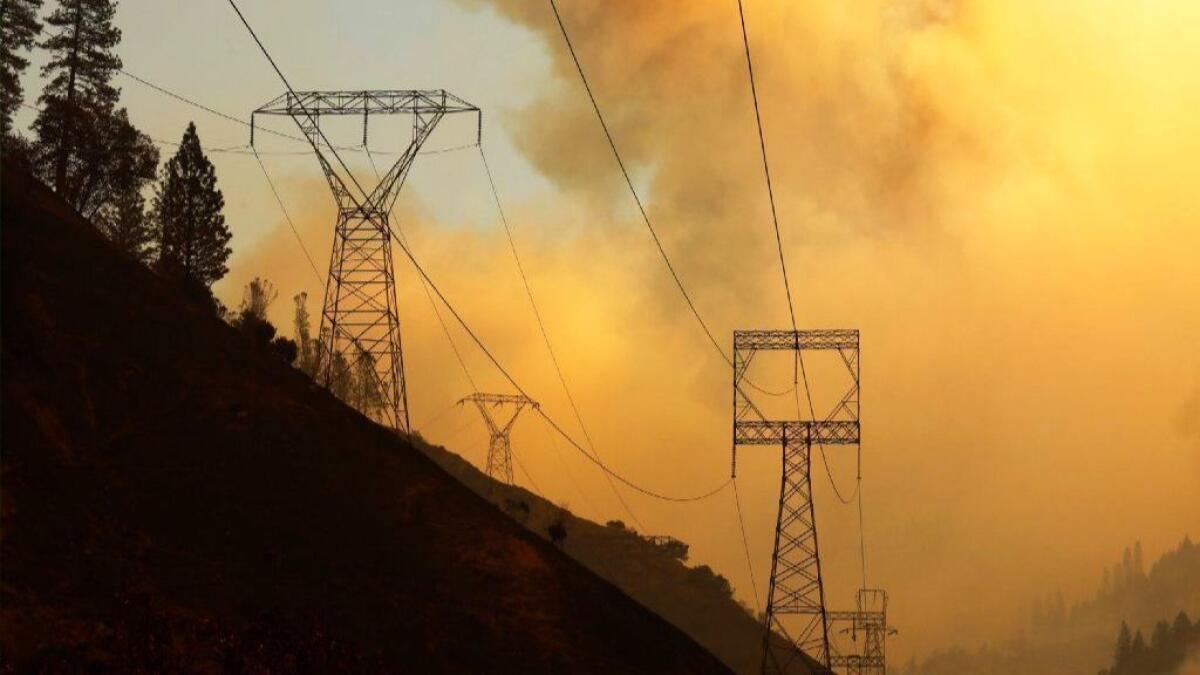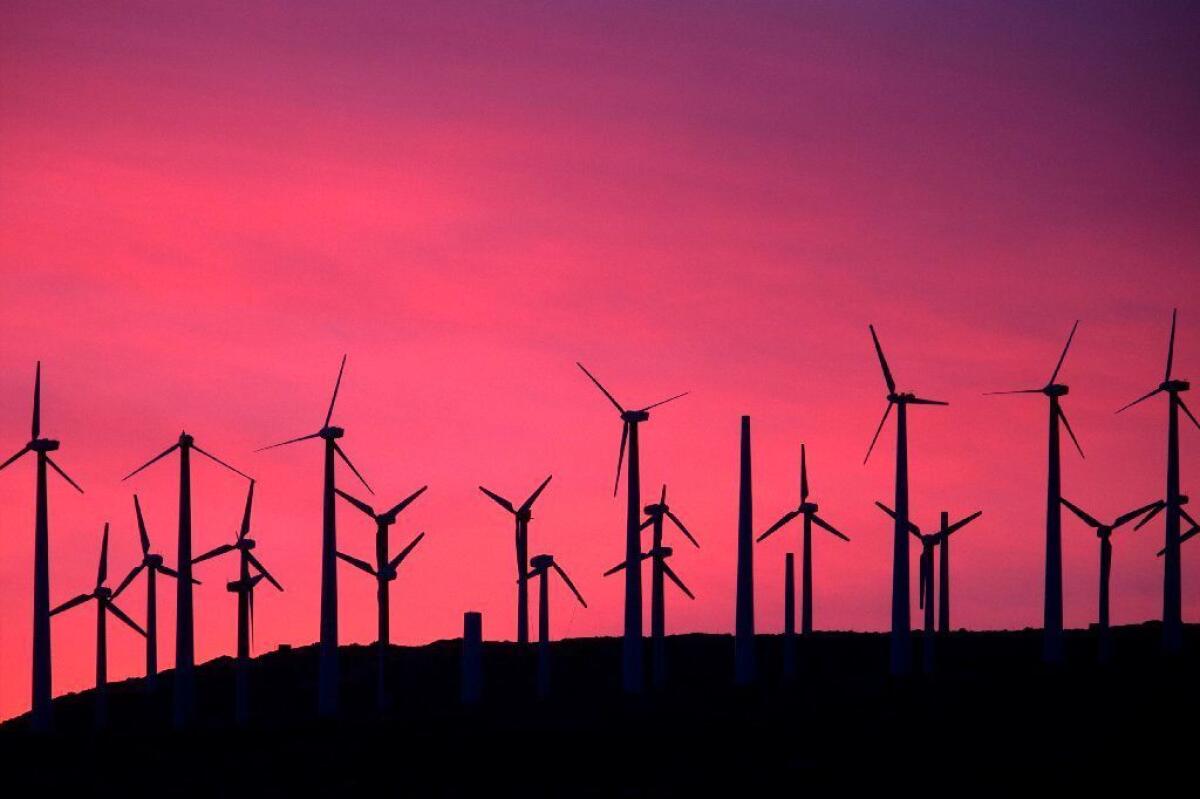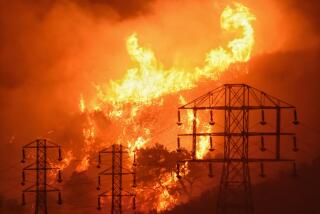PG&E’s bankruptcy could slow California’s fight against climate change

- Share via
Climate change helped fuel the deadly fires that prompted California’s largest power company to announce Monday that it would file for bankruptcy in the face of $30 billion in potential liabilities.
In a grim twist, the bankruptcy of PG&E Corp. could now slow California’s efforts to fight climate change.
UPDATE: Battered by wildfires and scandals, PG&E files for bankruptcy »
The Golden State has dramatically reduced planet-warming emissions from the electricity sector, largely by requiring utilities to increase their use of solar and wind power and fund energy efficiency upgrades for homes and businesses. Lawmakers recently set a target of 100% climate-friendly electricity by 2045.
But those government mandates have depended on PG&E’s Pacific Gas & Electric unit and other utilities being able to invest tens of billions of dollars in clean energy technologies.
PG&E’s ability to keep making those investments could be in serious jeopardy once it files for Chapter 11 bankruptcy protection, some energy experts say. Even before the company said it would file for bankruptcy, the looming threat of wildfire liabilities had decimated its credit rating, which raises the cost of borrowing capital.
The massive Topaz Solar Farm in California’s San Luis Obispo County, an electricity supplier to PG&E owned by Warren Buffett’s Berkshire Hathaway Energy, also saw its credit rating downgraded to junk status last week amid fears the San Francisco-based utility won’t be able to pay its bills in full.
In the short term, PG&E might stop signing renewable energy contracts, although contracting had already slowed in the last few years as customers departed in droves for newly established local energy providers run by city and county governments. In the long term, renewable energy developers and their lenders may hesitate to do business with PG&E — and, potentially, with other California utilities that could also face significant future wildfire costs.
“If we’re having a couple billion dollars a year of fire damage and insurance losses, quite apart from PG&E, this is going to put the entire state of California at risk,” said V. John White, executive director of the Center for Energy Efficiency and Renewable Technologies, a Sacramento-based trade group.
PG&E to file for bankruptcy as wildfire costs hit $30 billion. Its stock plunges 52% »
Renewable energy firms were alarmed by the news of PG&E’s impending bankruptcy filing, and it’s not hard to understand why. Solar and wind developers depend on stable, creditworthy utilities to buy electricity from their projects under long-term contracts known as power purchase agreements. They’re able to get low-cost loans to build their projects because lenders see little to no risk of a utility defaulting on those contracts.
But that calculus changes in a world where a 30-year power purchase agreement doesn’t guarantee 30 years of payments at the agreed-upon price, said Ben Serrurier, a San Francisco-based policy manager for solar developer Cypress Creek Renewables. There’s concern in the industry that a Bankruptcy Court judge could order PG&E to reduce its payments to solar and wind project owners to help the company pay off other debts.
“Once you start questioning the sanctity of contracted revenue, you begin to introduce a new risk into renewable energy project development. So much about project development is about reducing risk so you can reduce your capital cost,” Serrurier said.
It’s not just clean energy investments that are at risk. In another cruel bit of irony, PG&E’s bankruptcy filing could also make it more difficult for California utilities to raise the capital needed to harden their infrastructure against wildfire, said Travis Kavulla, a former president of the National Assn. of Regulatory Utility Commissioners who now serves as director of energy policy at the R Street Institute, a center-right think tank.
“Bankruptcies are tough. It means people may lose their pensions or get them cut. It means people who invested in projects in California, based on what they thought was a pretty airtight business model of a regulated utility, are getting stiffed,” Kavulla said. “It could create longer-running harms where California is viewed as a market to avoid investment in.”
PG&E has lurched from crisis to crisis since 2010, when one of the company’s gas pipelines exploded in a residential neighborhood in San Bruno, killing eight people. The company was ultimately fined $1.6 billion by state regulators and $3 million by a federal judge. Last month, the California Public Utilities Commission accused PG&E of continuing to commit pipeline safety violations in the years after the pipeline explosion.
More recently, deadly wildfires have made PG&E the target of raucous protests. The utility’s infrastructure was found to have sparked or contributed to more than a dozen fires that collectively killed 22 people in 2017. State investigators have yet to determine whether PG&E is also responsible for 2017’s Tubbs fire, which killed an additional 22 people, and the 2018 Camp fire, which killed 86 people and destroyed most of the town of Paradise.
PG&E, headed once again to bankruptcy, is anything but a master of disaster »
Some critics have called for lawmakers to break up the massive company, which serves 16 million Californians, and replace it with smaller, government-run electric utilities. But it’s unclear how feasible that would be, or whether it would accomplish anything more than transferring PG&E’s huge liabilities to local governments.
Renewable energy developers, meanwhile, see stabilizing PG&E as an urgent priority. After a string of fires devastated Northern California in October 2017, clean energy trade groups began urging state lawmakers to help PG&E and other utilities cope with the liability that can ensue if their infrastructure sparks a fire.
In a letter to legislative leaders last year, representatives of the solar, wind, geothermal and biomass energy industries said California must find a way to sustain financially solvent investor-owned utilities. Failure to act, they said, “imperils our markets and progress toward our climate goals.”
“The ability of California to meet its long-term greenhouse gas goals is directly dependent upon robust new investment in clean technologies. These investments are stymied with the addition of financial instability into the already complex California energy market,” the trade groups wrote in the letter in May.
Ralph Cavanagh, co-director of the energy program at the Natural Resources Defense Council, described PG&E as a “tremendous asset” for meeting the state’s climate change targets.
He said the state’s three big investor-owned utilities — which also include Southern California Edison and San Diego Gas & Electric — are crucial to making the investments needed to meet California’s ambitious climate targets, including the 100% clean energy mandate and a long-term goal of cutting greenhouse gas emissions by 80% below 1990 levels by 2050. Those investments are likely to include more solar and wind farms, large-scale batteries and other energy storage technologies, and electric vehicle chargers.
“Utilities have been essential clean energy partners. We don’t want to have to do without them, and we shouldn’t have to do it without them,” Cavanagh said. “It would be much more difficult without them.”

Cavanagh thinks state legislators should change the law so that PG&E and other utilities aren’t held liable for fires sparked by their infrastructure unless they’re found to be negligent.
“Our utility liability rules are unworkable. They menace every utility in California, and they need to be fixed,” he said. “This is not just about PG&E, and it’s a mistake to treat it as such.”
New Gov. Gavin Newsom could play a key role in determining how the state responds to PG&E’s bankruptcy. At a news conference Monday, he said the state is “still committed to investing in our climate goals.”
“I do not believe, based on the information that I have, that those goals will be significantly altered in the short term as it relates to existing purchases of renewable energy. We are long-term focused on all of the existing requirements that PG&E has encumbered and embraced,” Newsom said.
The Legislature already gave the investor-owned utilities a measure of relief last year by approving Senate Bill 901, which allows them to charge ratepayers for some of the costs they may incur from the 2017 fires. But it’s unclear whether lawmakers have the appetite for another bill that will inevitably be derided as a utility bailout.
Jamie Court, president of the Santa Monica-based nonprofit group Consumer Watchdog, described PG&E’s bankruptcy as a “manufactured crisis” designed to “evade accountability to homeowners and ratepayers.”
“This is designed to pressure a new governor, a new Legislature to do a new bailout after the ink is barely dry on the last one,” Court said. “There’s a phony crisis because there’s not a nickel they owe to anybody in those fires yet. It hasn’t happened.”
PG&E did file for bankruptcy once before, in the midst of an early-2000s energy crisis that stemmed from a failed deregulation scheme and led to rolling power outages in much of the state. But even veterans of that bankruptcy go-round say it’s difficult to predict exactly what will happen next.
PG&E didn’t have as many renewable energy contracts on the books then as it does now, and the state’s climate change targets weren’t as aggressive. A lot could depend on how the Bankruptcy Court judge handles the company’s existing solar and wind contracts, with developers watching to see whether the owners of those projects keep getting paid in full.
It’s also possible the effects of PG&E’s bankruptcy may not be as serious as solar and wind developers fear.
Ravi Manghani, director of energy storage at the research and consulting firm Wood Mackenzie Power & Renewables, said existing clean energy contracts “will likely get renegotiated,” with project owners being forced to accept lower payments. But in the long run, he said, California officials “are still committed to the renewable future, and it’s not like the region’s resource and reliability needs disappear with the bankruptcy.”
California wants 100% clean energy. But Los Angeles might invest billions in fossil fuels »
Another key factor: The investor-owned utilities aren’t the only ones buying clean energy in California.
Most new contracts in recent years have been signed by local energy providers known as community choice aggregators, or CCAs, which can be formed by city and county governments whose residents are served by an investor-owned utility. The government-run power agencies decide what kind of electricity to buy for their communities and how much to charge, while investor-owned utilities continue to operate the poles and wires.
There are 19 CCAs operating in California, including Clean Power Alliance, which will begin serving nearly 1 million homes in Los Angeles and Ventura counties in February. CCAs have signed long-term contracts for more than 2,000 megawatts of renewable energy, according to the California Community Choice Assn.
But the CCAs don’t have the financial wherewithal of the investor-owned utilities, and many of them don’t have credit ratings yet, said Matt Vespa, an attorney at the environmental group Earthjustice. He likes the CCAs but doesn’t think they alone can eliminate planet-warming carbon dioxide emissions from California’s electric grid.
“When you’re talking about the scale of what we need to do to aggressively decarbonize … they’re not in a position to finance that,” Vespa said.
More to Read
Inside the business of entertainment
The Wide Shot brings you news, analysis and insights on everything from streaming wars to production — and what it all means for the future.
You may occasionally receive promotional content from the Los Angeles Times.











